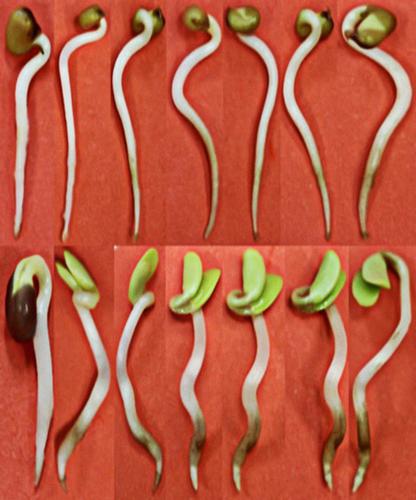当前位置:
X-MOL 学术
›
Plant Pathol.
›
论文详情
Our official English website, www.x-mol.net, welcomes your
feedback! (Note: you will need to create a separate account there.)
Plant genotype and temperature impact simultaneous biotic and abiotic stress related gene expression in Pythium‐ infected plants
Plant Pathology ( IF 2.3 ) Pub Date : 2020-05-01 , DOI: 10.1111/ppa.13149 Ming Pei You 1 , Tian Rui 1 , Martin J. Barbetti 1
Plant Pathology ( IF 2.3 ) Pub Date : 2020-05-01 , DOI: 10.1111/ppa.13149 Ming Pei You 1 , Tian Rui 1 , Martin J. Barbetti 1
Affiliation

|
Under changing climate, plants need combined ability to cope with co‐occurring biotic/abiotic stresses. Understanding simultaneous plant responses to multiple stresses offers unique insights towards developing effective strategies to mitigate effects of such stresses in plants. Quantitative reverse transcription PCR was used to determine and compare relative gene expression ratios (RGERs) of three disease resistance‐related genes, chalcone synthase, GA protein, and phenylalanine ammonia lyase (PAL), and three abiotic stress‐related genes, a LRR receptor‐like protein kinase (RPK), heat shock protein 81, and Trifolium repens cold responsive protein, across seven durations of infection by the root pathogen Pythium irregulare under three temperature regimes in three Trifolium subterraneum varieties of varying resistance. Temperature and genotype drove biotic and abiotic stress‐related gene expression in Pythium‐infected plants. RGERs of tested genes and their relationships differed across varieties, temperatures, and infection duration (ID). These are the first studies to report expression of defence‐related genes in relation to either biotic or abiotic stress in subterranean clover. The current study not only demonstrates how RGERs of tested genes and their relationships differ across varieties, temperatures, and ID, but also highlights as yet unexploited opportunities to use these biotic/abiotic‐related genes together to develop new varieties with combined biotic/abiotic stress resistances in forage legumes that are suitable for changing climate scenarios. Examples could include RGERs of PAL to identify “temperature‐stable” disease‐resistant varieties, and RGERs of RPK to eliminate susceptible and temperature‐sensitive genotypes.
中文翻译:

植物基因型和温度同时影响腐霉感染植物中生物和非生物胁迫相关基因的表达
在气候变化下,植物需要综合能力来应对同时发生的生物/非生物胁迫。了解植物对多种胁迫的同步反应为开发有效策略以减轻植物中此类胁迫的影响提供了独特的见解。定量逆转录 PCR 用于确定和比较三种抗病相关基因查耳酮合酶、GA 蛋白和苯丙氨酸解氨酶 (PAL) 和三个非生物胁迫相关基因 LRR 受体的相对基因表达比 (RGER)。样蛋白激酶 (RPK)、热休克蛋白 81 和 Trifolium repens 冷响应蛋白,在三种不同抗性的 Trifolium subterraneum 品种中,在三种温度条件下根部病原体 Pythiuminforme 感染的七个持续时间。温度和基因型驱动腐霉感染植物中的生物和非生物胁迫相关基因表达。测试基因的 RGER 及其关系因品种、温度和感染持续时间 (ID) 而异。这些是第一项报告与地下三叶草中生物或非生物胁迫相关的防御相关基因表达的研究。目前的研究不仅证明了测试基因的 RGER 及其关系在品种、温度和 ID 之间的差异,而且还强调了将这些生物/非生物相关基因一起使用以开发具有组合生物/非生物胁迫的新品种的尚未开发的机会适用于气候变化情景的豆科牧草抗性。例子可能包括 PAL 的 RGER,以识别“温度稳定”的抗病品种,
更新日期:2020-05-01
中文翻译:

植物基因型和温度同时影响腐霉感染植物中生物和非生物胁迫相关基因的表达
在气候变化下,植物需要综合能力来应对同时发生的生物/非生物胁迫。了解植物对多种胁迫的同步反应为开发有效策略以减轻植物中此类胁迫的影响提供了独特的见解。定量逆转录 PCR 用于确定和比较三种抗病相关基因查耳酮合酶、GA 蛋白和苯丙氨酸解氨酶 (PAL) 和三个非生物胁迫相关基因 LRR 受体的相对基因表达比 (RGER)。样蛋白激酶 (RPK)、热休克蛋白 81 和 Trifolium repens 冷响应蛋白,在三种不同抗性的 Trifolium subterraneum 品种中,在三种温度条件下根部病原体 Pythiuminforme 感染的七个持续时间。温度和基因型驱动腐霉感染植物中的生物和非生物胁迫相关基因表达。测试基因的 RGER 及其关系因品种、温度和感染持续时间 (ID) 而异。这些是第一项报告与地下三叶草中生物或非生物胁迫相关的防御相关基因表达的研究。目前的研究不仅证明了测试基因的 RGER 及其关系在品种、温度和 ID 之间的差异,而且还强调了将这些生物/非生物相关基因一起使用以开发具有组合生物/非生物胁迫的新品种的尚未开发的机会适用于气候变化情景的豆科牧草抗性。例子可能包括 PAL 的 RGER,以识别“温度稳定”的抗病品种,











































 京公网安备 11010802027423号
京公网安备 11010802027423号